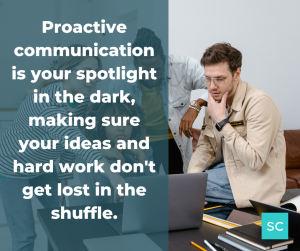Proactive Communication For Visibility
In today’s fast-paced professional world, having great communications skills is so important. Whether you’re tackling the office hustle, teaming up from afar with colleagues around the world, or trying to shine in a cutthroat industry, your knack for speaking up and keeping the conversation flowing is the golden ticket to getting noticed at work.
Proactive communication is your spotlight in the dark, making sure your ideas and hard work don’t get lost in the shuffle.
It’s not just about staying on everyone’s radar; it’s about being the go-to person and a trusted teammate in a game where being seen often leads to bigger opportunities.
 Our CEO and Founder, Jessica Chen, recently hosted a Soulcast Media | LIVE event on LinkedIn. She shared tips and personal stories about proactive communication for visibility and how to create a career brand.
Our CEO and Founder, Jessica Chen, recently hosted a Soulcast Media | LIVE event on LinkedIn. She shared tips and personal stories about proactive communication for visibility and how to create a career brand.
1. Visibility Mindset
Embracing a “visibility mindset” is a game-changer in our careers. If we’re not out there, making our presence felt, how can we expect anyone to notice us? Being visible isn’t just a nice-to-have; it’s like putting your name in neon lights, making sure you’re in the spotlight, and paving the way for others to take notice. So, remember, if you don’t advocate for yourself, don’t be surprised if others don’t either.
Consider the following:
- Share Your Wins – When you’ve got a win under your belt, it’s time to spread the good news. Sure, it can sometimes feel a bit awkward, but it’s all in the delivery. For instance, you could just say, “Hey, check this out!” Short and sweet, right? It’s not about bragging; it’s about sharing the excitement, and keeping it concise can help you do that without making it feel like you’re putting yourself on a pedestal.
- Meetings – Raising your voice in meetings can increase your visibility at work. For example, jumping into the conversation within the first five minutes is like starting a meeting on the right foot. It’s like, “Hey, I’m here, and I’ve got something to say!” And then there’s this excellent technique called “anchoring.” It’s like building a bridge with what someone else just said and walking right across it with your thoughts. Not only do you add value to the conversation, but it’s also a way of giving props to your colleagues for their ideas.
- Proactive Communications – In the daily whirlwind of office life, it’s easy for everyone, whether our higher-ups or coworkers, to get caught up in their tasks and to-dos. But here’s the deal: staying on their radar is important. Let’s say your boss is out of town or things have been too hectic to chat – no worries. A quick email like, “Hey, no need to reply, just a quick update on ABC” can do wonders. It’s all about being simple, to the point, and taking the initiative.
Having a visibility mindset is all about proudly owning the fantastic stuff we do and putting it on display for everyone to see.
2. Build An Army Of Supporters
When you’ve got a solid support crew, these folks can become like your own personal cheering squad at work. It’s all about making those connections and using them in a real and effective way to help you achieve your career dreams.
Three support groups you can create:
- Advisors – Our advisors are like the rock stars of our support team. So, when you’ve got a fresh idea or proposal about to hit your manager’s desk, these are the folks you want to chat with. They’re like your idea-refining buddies. Reaching out to them for their two cents isn’t just about honing your ideas; it’s also about adding another brick to your relationship with these all-important supporters.

- Endorsers – Once we’ve polished up our ideas with our trusty advisors, it’s time to tag in the endorsers. Endorsers are like the VIPs who are all in for making your plans happen because they see the value and how it’s a win-win. They’re not just excited; they’ve got the ability and connections to really push your idea into the spotlight. These endorsers they’re the ones who can help get the ball rolling and turn your ideas into full-blown reality.
- Approvers – Once you’ve got the nod from your trusty advisors and endorsers, it’s time to pinpoint the approvers. These are the folks who hold the keys to saying, “Yes, let’s go for it!” Armed with the wisdom and the thumbs-up from your advisors and supporters, you’re set to make a pretty strong case to these decision-makers. Having your network behind you makes it way more likely that you’ll get the green light and roll closer to your goals.
Building your army of supporters can keep you in the spotlight.
3. Mastering The ASK
Bringing up the topic of more leadership responsibilities or a raise with your manager can be nerve-wracking. But here’s the deal – when you walk in there with confidence, your chances of a positive response shoot up. And how do you get that confidence? It starts with a communications framework.
SAW Framework:
- Strong Case – If you want to make a strong case, here are a few questions to remember: Why is this the right time? Who will be on the winning end, and why does it matter? Of course, your request benefits you, but if you can zoom out and see the bigger picture, your manager is more likely to be on board. Let’s say you’re pitching a project and aiming for a leadership role; you could pitch it like, “This new project will supercharge our department’s efficiency and crank up productivity.” Sure, it’s a leadership opportunity for you, but the real deal is how it will boost the entire department. So, make sure you show how everyone’s in for a win.

- Align Your Objectives – As you gear up for your big ask, take a moment to think about the dollars and resources it might require and where those resources will come from. Think about if what you’re asking for will be a bang for the buck for the whole team or organization. Say you’re eyeing some fancy new software for your department. Sure, there’s that upfront cost. But if you can paint the picture of how it will be a real money-saver in the long run, you’re stacking the odds in your favor for that approval.
- Why You – When you’re gearing up for that ask, make sure you’ve got a rock-solid case for why you’re the go-to person for the job. Take leading a project, for instance. You’ve got to paint the picture of why you’re the right one to captain the ship. Chat about all those projects you’ve been part of, your role, and how those experiences have prepared you to steer the ship this time. And don’t forget to talk about why you’re all in for the job. Your passion and drive can be just as persuasive as your skills.
Nailing your “ask” is like the ultimate confidence booster when it comes to speaking up at work.
Taking the extra mile in proactively communicating can genuinely help you to make your presence known and valued in the professional arena.
__
Whenever you’re ready, there are 3 ways we can help you:
- Discover your communications style so you know where to start. Over 4,000 people have found theirs here.
- Attend our monthly communication workshop to build communications confidence (new topics: public speaking, advocating for yourself, building credibility, etc) here.
- Get your brand in front of 43k+ people by sponsoring our newsletter or Soulcast Media | LIVE LinkedIn events [contact: hello@soulcastmedia.com]











